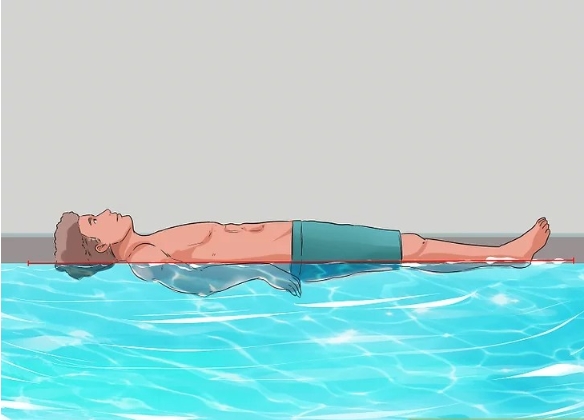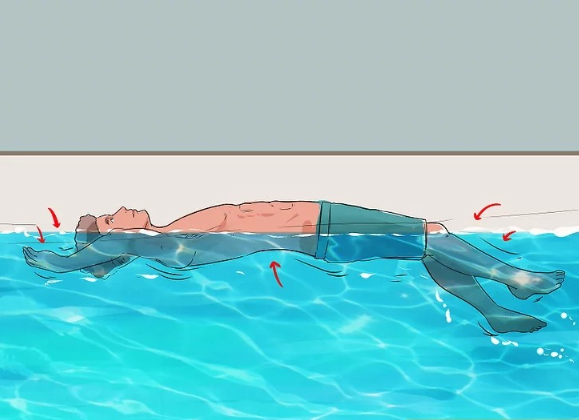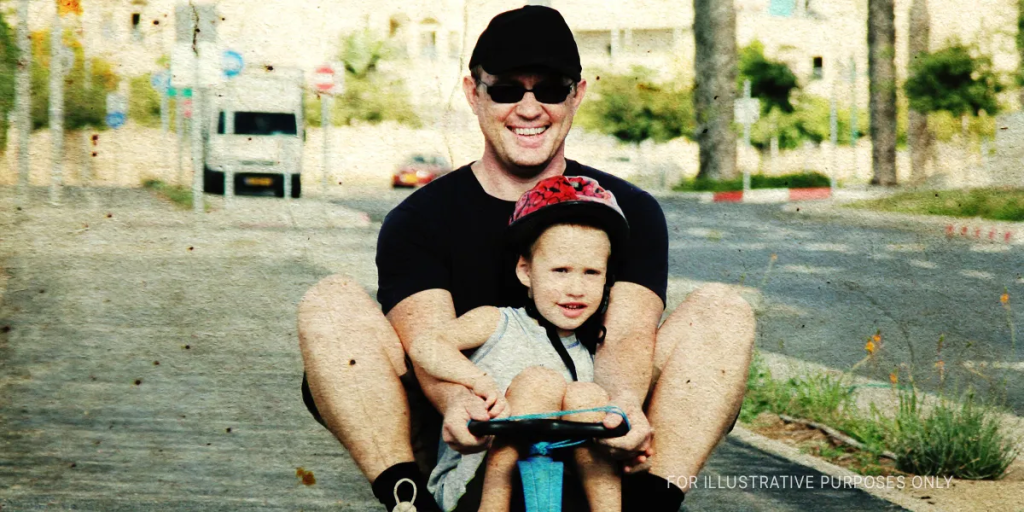Falling into deep water unexpectedly can be a terrifying experience, especially if you don’t know how to swim. Panic sets in, your instincts tell you to struggle, and before you know it, you’re exhausted and in real danger. However, survival in such a situation is entirely possible if you remain calm and follow a set of simple but life-saving steps.
According to Dr. Nash and his team of researchers, the key to survival is overcoming fear instincts and following five crucial steps. These steps are designed to help anyone—regardless of swimming ability—stay afloat, breathe, and increase their chances of rescue. Let’s dive into these life-saving techniques.
1. Stay Calm and Relax to Achieve Natural Buoyancy

The first and most critical step is to fight the urge to struggle. Many people instinctively flail their arms and legs in a desperate attempt to stay above water. However, this only wastes energy and causes faster exhaustion.
Instead, take a deep breath and allow your body to relax. When you stop panicking, your body will naturally float closer to the water’s surface. The human body is slightly less dense than water, meaning that if you remain still, you can achieve buoyancy without much effort.
2. Tilt Your Head Back to Keep Your Airway Clear
Once you’ve calmed yourself and started floating, you need to ensure that you can breathe. The best way to do this is to tilt your head back, keeping your face above the water.
Try not to move too much, as sudden movements can make you sink slightly. If you feel yourself going under, resist the urge to panic—simply take a deep breath, relax your muscles, and allow yourself to rise again.
Video : How to Survive if You Fall in Water – Prevent Yourself From Drowning – Survival Techniques
3. Breathe Slowly and Avoid Inhaling Water
Now that your nose and mouth are above water, it’s time to focus on breathing. Many people instinctively gasp for air, but this can lead to choking if water splashes into your mouth. Instead, practice controlled breathing:
- Exhale slowly through your nose to clear any water that may have entered.
- Inhale through your mouth in a controlled manner.
- If a wave covers your face, hold your breath momentarily, then resume normal breathing.
Even experienced swimmers can struggle if they inhale water, so maintaining steady breathing is crucial for survival.
4. Move Your Arms and Legs Gently to Stay Afloat
At this point, you should be floating on the water’s surface and breathing steadily. The next step is to use gentle, controlled movements to maintain your position.
- Use slow arm movements: Move your arms in a sweeping motion, like you’re making small circles in the water. This will help you stay afloat without expending too much energy.
- Legs should remain still if you don’t know how to kick properly: If you’re unsure how to tread water, keeping your legs still is often better than kicking randomly. Let them sink slightly while focusing on keeping your upper body above water.
The key here is to avoid frantic movements—slow and deliberate strokes will keep you afloat much longer.

5. Look for Rescue Opportunities
Once you’ve gained control of your breathing and movements, your next priority is finding a way to safety.
- Scan your surroundings – Look for anything floating that you can grab onto, such as a buoy, a log, or even a piece of debris. Holding onto something will help you conserve energy.
- Check your distance from the shore – If you can see land, assess whether it’s possible to move toward it using slow, steady movements.
- Signal for help – If there are people nearby, shout for help. However, conserve energy by calling out only when necessary.
If you’re caught in a strong current, do not try to swim directly against it—this will only tire you out. Instead, swim diagonally at an angle to gradually move out of the current’s pull.
What to Do If You See Someone Drowning
If you witness someone struggling in deep water, it’s important to act quickly but safely. Jumping in to rescue them may seem like the right thing to do, but unless you’re a trained rescuer, it could put both of you at risk.
Instead, follow these steps:
- Shout instructions – Encourage the person to follow the survival steps above. Remind them to relax, tilt their head back, and float.
- Find a flotation device – If possible, throw a life jacket, a rope, or any floating object they can grab onto.
- Call emergency services – Immediately contact your local emergency number and provide details of the situation.
Video : How to get over fear of water – Feel safe on the deep end
Why Staying Calm is the Key to Survival
Many drowning incidents occur not because the victim physically sinks, but because they panic and exhaust themselves. Learning how to override panic instincts and follow a survival routine can mean the difference between life and death.
Dr. Nash explains:
“Whether you’re planning a vacation, taking a walk near a river, or going for a swim, knowing how to stay safe in water is crucial. These simple survival techniques can save your life or someone else’s.”
Final Thoughts
Surviving a fall into deep water without knowing how to swim is possible—but only if you remain calm and follow the right steps. By floating, maintaining steady breathing, and making slow movements, you can conserve energy and increase your chances of rescue.
Now that you know these survival strategies, share them with your friends and family. You never know when this knowledge might save a life!
13 Years Ago Was the Last Time I Saw My Daughter, Today I Got a Christmas Letter from Her – My Story

Over a decade ago, I lost my job and family because I didn’t take myself seriously. After slowly piecing my life together, I finally have a chance at redemption with my estranged daughter.
I used to be an ambitious young man with the world at my feet. I always saw myself running my own business, and for a while, I believed that I was on the right path. Looking back, I think this passion made my ex-wife, Rebecca, first fall in love with me. She even supported me during the humble beginnings of my old repair shop.
Rebecca and I had our daughter, Harriet, during this time. Unfortunately, my repair shop went bankrupt. I began to feel depressed and lost motivation. I worked as a waiter to make ends meet, but I couldn’t provide a stable lifestyle for my family.
“When are you going to get a real job?” Rebecca asked me. I had no answer. Even though I had a great relationship with Harriet during her childhood, my marriage slowly fell apart.
Rebecca and I fought all the time, and we grew further apart. One day, I was called into the restaurant and told they could no longer keep me on the staff. “We’re going to have to let you go, Jimmy,” my manager told me.

For illustrative purposes only. | Source: Unsplash
At the time, I was at such a low point in my life that I didn’t even care. Perhaps I thought Rebecca could care for me while I looked for a new job. That day I went home and took a walk with my family. Harriet was riding in her little car with foot pedals. Rebecca had a solemn demeanor, and I sensed something was wrong.
“I’m leaving you, Jimmy. I just can’t do this anymore. It’s obvious that you’ve given up on everything,” She told me. In one day, my entire world had come crashing down. I tried to convince Rebecca to give me one more chance, but her mind had already been made up. I gave my daughter a big hug.
“Mom always told me you were a loser and I should forget about you, but I can see that you’ve changed.”
“Daddy will always love you no matter, okay Harriet?” I told her. I could tell that she didn’t understand what was going on. By the following day, Rebecca and Harriet were out of the house, and I was all alone. Rebecca took full custody of our daughter as I was unemployed.
It was only then that I realized how much of a loser I was. I couldn’t even take care of Harriet as I had no savings or job lined up. In what felt like a few months, Rebecca had already moved in with a new partner, Eric. “Until you get your life in order, don’t even think about talking to Harriet,” Rebecca told me.

For illustrative purposes only. | Source: Unsplash
I used the last of my money to buy Harriet a gift for her birthday party, a small bunny rabbit. I also wrote a note which read, “I miss you so much. Happy Birthday. Love Daddy.”
When I reached Eric’s house, I saw he was pretty rich. He had thrown a big birthday party for Harriet, with mascots and a jumping castle. I felt ashamed. My daughter had a new dad. Eric could provide Harriet with things I couldn’t even dream of buying.
I left my gift at their front gate and left. At this point, I was in a very dark place and couldn’t see a way forward. I decided to leave the coast and move cities. All I had to my name was the house my father, Frank, left me.
Since I was flat broke, I sold the house and moved into an apartment in a town in a different state.
I worked odd jobs at times to make a bit of money. Two years after I left my family behind, I was broke again. The following month, I was evicted. I found myself out on the street with nowhere to turn.

For illustrative purposes only. | Source: Unsplash
I can’t keep living like this, I realized. I walked into the local store and begged for a job. The manager recognized me from around town and gave me a chance as a cleaner in the store. In the next few months, I was promoted to cashier, and within a year, I was made administrator of the whole store.
Even though I was finally financially stable and had cleaned up my act, I was still very lonely. Years flew by, and I still wasn’t in contact with any of my family, and I had no real friends. I regularly gave some of my money to charity because I had no one to spend it on.
That all changed today, as for the first time in ages, I received mail that wasn’t an outstanding bill. It was a Christmas letter from Harriet!

For illustrative purposes only. | Source: Unsplash
It has been 13 years since I’ve seen I have seen or heard from my daughter but I’ve been blessed with a Christmas miracle. Her words warmed my heart in a way that I haven’t felt in years. Her letter read:
“Hi, Dad. I’ve finally found you! This may come as a shock, but I’ll be flying in to see you tomorrow. We have so much to talk about. Even though mom and Eric provided me with everything growing up, I always wondered when you would come back.
Mom always told me you were a loser and I should forget about you, but I can see that you’ve changed and got yourself together. Just so you know, I still have the stuffed bunny you left me for my birthday. I named him Jimmy, so in a way, you’ve been with me all along!
See you soon. I love you, and I can’t wait.
Merry Christmas, Dad!”
This is the most incredible day of my life. I’ve missed my daughter so much, and I never thought I’d get this opportunity. I changed my life for the better and did what I could to help my community.

For illustrative purposes only. | Source: Unsplash
Although I felt too ashamed to return home, God has blessed me with a second chance with Harriet. This time, I’ll do everything I can to make her proud and make up for all the time we missed together. After 13 long years, I finally have my shot at redemption.
Have you ever had a moment when you needed to start life with a clean slate? How did you survive it?
Share this story with your friends. It might brighten their day and inspire them.
If you enjoyed this story, you might like this one about a man who abandons his family and is recognized 20 years later begging in the streets by his estranged daughter.
This piece is inspired by stories from the everyday lives of our readers and written by a professional writer. Any resemblance to actual names or locations is purely coincidental. All images are for illustration purposes only. Share your story with us; maybe it will change someone’s life.



Leave a Reply